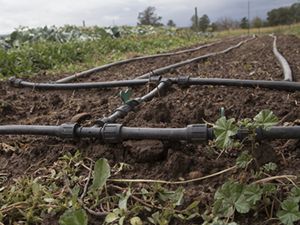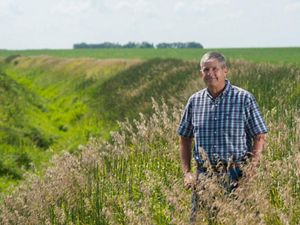Stopping the Cycle of Dead Zones in the Gulf and Beyond
By Justin Adams and Larry Clemens
Justin Adams is the Executive Director of the Tropical Forest Alliance (currently seconded to the TFA from from The Nature Conservancy) and Larry Clemens is the Director of North America Agriculture at The Nature Conservancy.
In the world of science, size matters. Case in point: the National Oceanic and Atmospheric Administration says this year's "dead zone” in the Gulf of America—an area of oxygen-depleted water where little to no marine life exists, caused by excess nutrient runoff—is the largest that has ever appeared since monitoring began 32 years ago.
Stretching from the Mississippi River Delta in Louisiana westward to the Texas coast, the dead zone covers 8,776 square miles, an area about the size of New Jersey. (Keep in mind, the average size of the dead zone is still quite large at 5,309 square miles—roughly the size of Connecticut.)
Why so big this year? Most likely it’s because heavy rains in late spring flushed hundreds of thousands of tons of nitrates from farmlands, cities, and other sources into waterways throughout the 31-state Mississippi River Basin that eventually empty into the Gulf.
An overabundance of nutrients can cause algae to grow abnormally fast. When algal blooms die, the decaying matter consumes the oxygen and snuffs out fish, shellfish, coral and vegetation, causing a hypoxic area, or dead zone.
Nutrient runoff is a considerable threat to North America’s marine and fresh water systems, threatening natural areas and wildlife habitat, tainting drinking water supplies, and imposing tremendous water treatment costs on communities.
In particular, the dead zone threatens the commercial and recreational fisheries of the Gulf, valued at almost $1 billion. It also drives up the price of large shrimp relative to smaller sizes, causing economic ripples that can affect consumers, fishermen and seafood markets alike.

In short, a dead zone in the Gulf can affect your Sunday lunch. But dead zones are not confined to U.S. waters: They affect dozens of coral reefs around the world stretching from South America to Japan and elsewhere and threaten hundreds more, according to a new study by Smithsonian scientists published in Proceedings of the National Academy of Sciences.
Fortunately, there are proven solutions. The Nature Conservancy is working with farmers, academia, governments, and the agriculture industry to tackle the challenge of nutrient runoff. A key goal is to help keep nutrients on fields and out of waterways through different farming practices—such as using cover crops, reduced tillage, crop rotation and nutrient management to the benefit of both farmers and the environment.
The Conservancy and its partners are working in the Mississippi Basin and beyond to enlist the help of nutrient service providers—key advisors to farmers—to promote a science-based approach to apply the right source and rate of nutrients at the right time and place on croplands. Known as the 4Rs of nutrient stewardship, this approach is proven to reduce nutrient runoff while increasing farmers’ profits.
The Conservancy has also been working with farmers and other partners along Wisconsin’s Pecatonica River, a tributary of the Mississippi, for a decade testing new approaches to reducing phosphorus and improving water quality in streams. Our results confirmed that targeting agricultural lands with the highest incidences of runoff, rather than randomly throughout a watershed, will result in cleaner water.
Another science-based solution to nutrient runoff is to restore floodplains, which can slow the flow of the water, naturally capturing nutrients that would otherwise drift downstream.
To date, the U.S. Department of Agriculture’s Natural Resources Conservation Service, along with the Conservancy and others, have helped protect or restore 44,000 acres of floodplain habitat along the Wabash River – a tributary in Indiana and Illinois responsible for delivering a disproportionately high nitrogen load to the Gulf of America. The Conservancy’s goal is to protect or restore an additional 10,000 acres along the Wabash by 2022.

We know this type of restoration works. John White, Ph.D, a scientist at Louisiana State University, and his team, with field assistance from the Conservancy, measured the levels of nitrogen removal from two sites in north Louisiana: Mollicy Farms, a restored forested floodplain project site, and a nearby natural forested wetland. Dr. White and his team discovered that the restored site removed almost as much nitrogen as the natural floodplain, reinforcing that we should restore floodplains whenever possible.
This year’s dead zone prediction in the Gulf of America doesn’t undercut progress to reduce nutrient runoff. Like a down day at the stock market in the midst of bull market, bad news in conservation isn’t always an indicator of an overall trend and doesn’t mean we should abandon effective long-term strategies.
Conservation success hinges on the collaborative spirit of cities, farmers, agribusiness and policy makers to embrace science-based solutions, both on the ground and at the policy level. Then we’ll really have a bull market, and hopefully in response, smaller dead zones, cleaner water, and healthy crops.
Size does matter—but intelligence and action matter more.
Originally Posted on Treehugger
August 3, 2017
View Original
Global Insights
Check out our latest thinking and real-world solutions to some of the most complex challenges facing people and the planet today.



